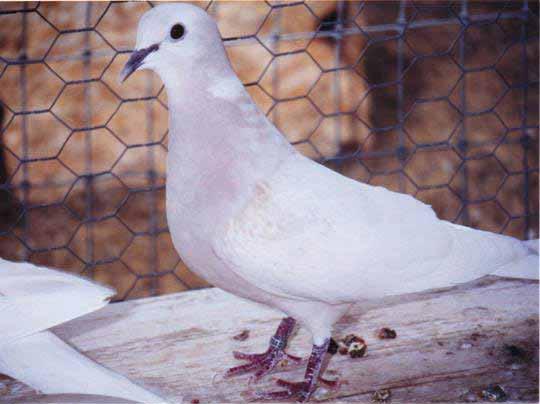Dove - ringneck
Ringneck Dove Scientific Name: Streptopelia risoria
Sun, 13th July, 2025 - 7:42 am GMT
Sponsor Ads:

Alternative Name
Ringneck Dove Scientific Name: Streptopelia risoriaBasic Info
The domestic Ring Neck Dove comes in a variety of colors. Originally whites and fawns were the only colors available. In the 1960's breeders began experimenting and through selective breeding have developed a large number of varieties. Please see the related article on dove color variations 'Ring Neck Doves: A Rainbow of Color Varieties' for detailed descriptions of each variety. Over the years much research has been done behind the genetics of dove color variations. Some of the findings include the discovery of a sex-linked gene that contributes to the white color in many varieties. In addition it was discovered that many other colors including dark and blonde had sex-linked gene origins. It must be noted that the gene responsible for the Albino versions is not the same for normal whites. The Albino coloration is a result of a genetic mutation which gives rise to a lack of melanin. Melanin is what is responsible for coloring in all animals. Recessive genes cause some of the color variations; one such example is the Rosy variation. The first dominant gene caused color mutation was the tangerine. New color variations are emerging constantly. The Ring Neck Dove lives an average 15 years, though some may live over 25 years.
Health
Ringneck Doves are easy to care for. They make great pets and tame easily. They are not known to bite and for this reason they can be handled by children and adults, alike. They can be kept in either large indoor cages or in aviaries. If kept in a cage, a Cockatiel or Parrot sized cage is ideal, as long as they get some flight time outside the cage each week. Ringneck Doves can be tamed easily, usually with very little effort. Wing clipping is not necessary and is not recommended for doves because they cannot climb to safety, like parrot family birds. Ringneck Doves should never be released outside like Pigeons because they have very poor homing instincts and usually will not survive for very long. Breeding Ring Neck Doves can be bred as early as six months of age. Incubation is approximately 10 to 14 days, with hatchlings remaining in the nest with parents until one to two months of age. It is not uncommon for a mating pair to raise five broods within a single year. Both male and female Ring Neck Doves act as parents.Habitat
N/ABehavior
The domestic Ring Neck Dove has been a favorite of fanciers for thousands of years. They have been kept all over the world. The Ring Neck Dove or Laughing Dove is perhaps best known for its gentle temperament. They are good-natured social creatures that do well kept in indoor and outdoor aviaries. The Ring Neck Dove must be kept in an aviary, which allows plenty of room for flight. They do well in both indoor and outdoor cages.Origin
United KingdomHistory
The Ring Neck Dove has been kept domestically for at least 1,000 years. Some sources say over 2,000. Initially they were used for sacrifice in religious rituals and latter were bred as pets. Ring Neck Doves were commonplace in the United States beginning with the first settlers who traveled with Columbus on his maiden voyages. The Ring Neck Dove today is kept as a pet in aviaries throughout the UK. This strain (Streptopelia risoria) differs from the wild variety (Streptopelia decaocto) seen commonly in flight within the UK.Common Foods
For feeding, a regular parakeet seed mixture is fine. You can also mix some safflower seed and cracked corn into a parakeet mixture for more variety. There are also some seed mixtures available, specifically for doves. Being seed-eating birds, grit is essSponsor Ads:
Chisholm's Second Law: When things are going well, something will go wrong.
Dove - ringneck
Coded by: BGID® | ALL RIGHTS RESERVED Copyright © 2000-2025
Disclaimer | Privacy | Report Errors / Contact | Credits


 President of the United States of America - Real Estate mogul, Pageant owner and now one of the most controversial men in political history.
President of the United States of America - Real Estate mogul, Pageant owner and now one of the most controversial men in political history.  Global warming has been in and out as the "latest" hot topic for many years. It is, according to modern scientists, the result of man-made industrial pollutants, clearing forested areas, agriculture, etc. But now they are thinking it started way before the Industrial Revolution...
Global warming has been in and out as the "latest" hot topic for many years. It is, according to modern scientists, the result of man-made industrial pollutants, clearing forested areas, agriculture, etc. But now they are thinking it started way before the Industrial Revolution...  Politician, US Vice President and President of the USA - Joseph Robinette Biden Jr.
Politician, US Vice President and President of the USA - Joseph Robinette Biden Jr.  versus
versus  Russia: 'The Evil Empire'? Are they all that bad or is it just the USA trying to portray Russia as bad because they are a world power with land bigger and a society very different from the USA ideal?
Russia: 'The Evil Empire'? Are they all that bad or is it just the USA trying to portray Russia as bad because they are a world power with land bigger and a society very different from the USA ideal? 
 Corona virus
Corona virus 
 Users with wide screen monitors can benefit from more content on every page.
Users with wide screen monitors can benefit from more content on every page.